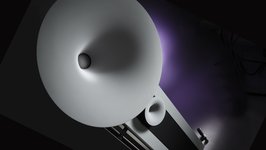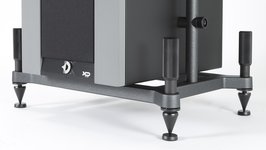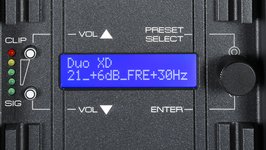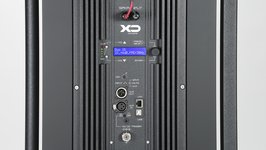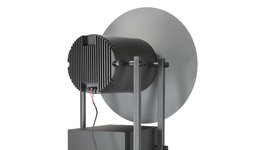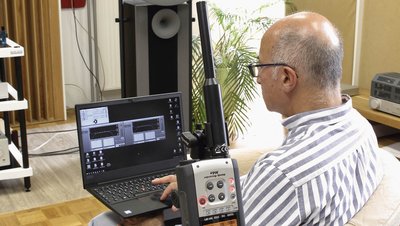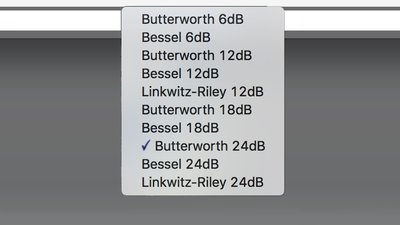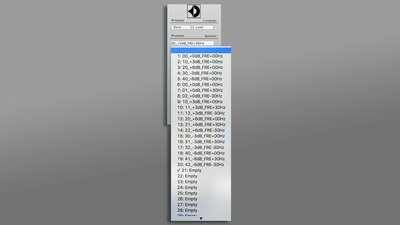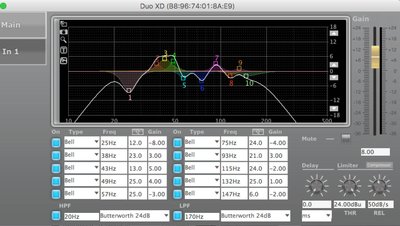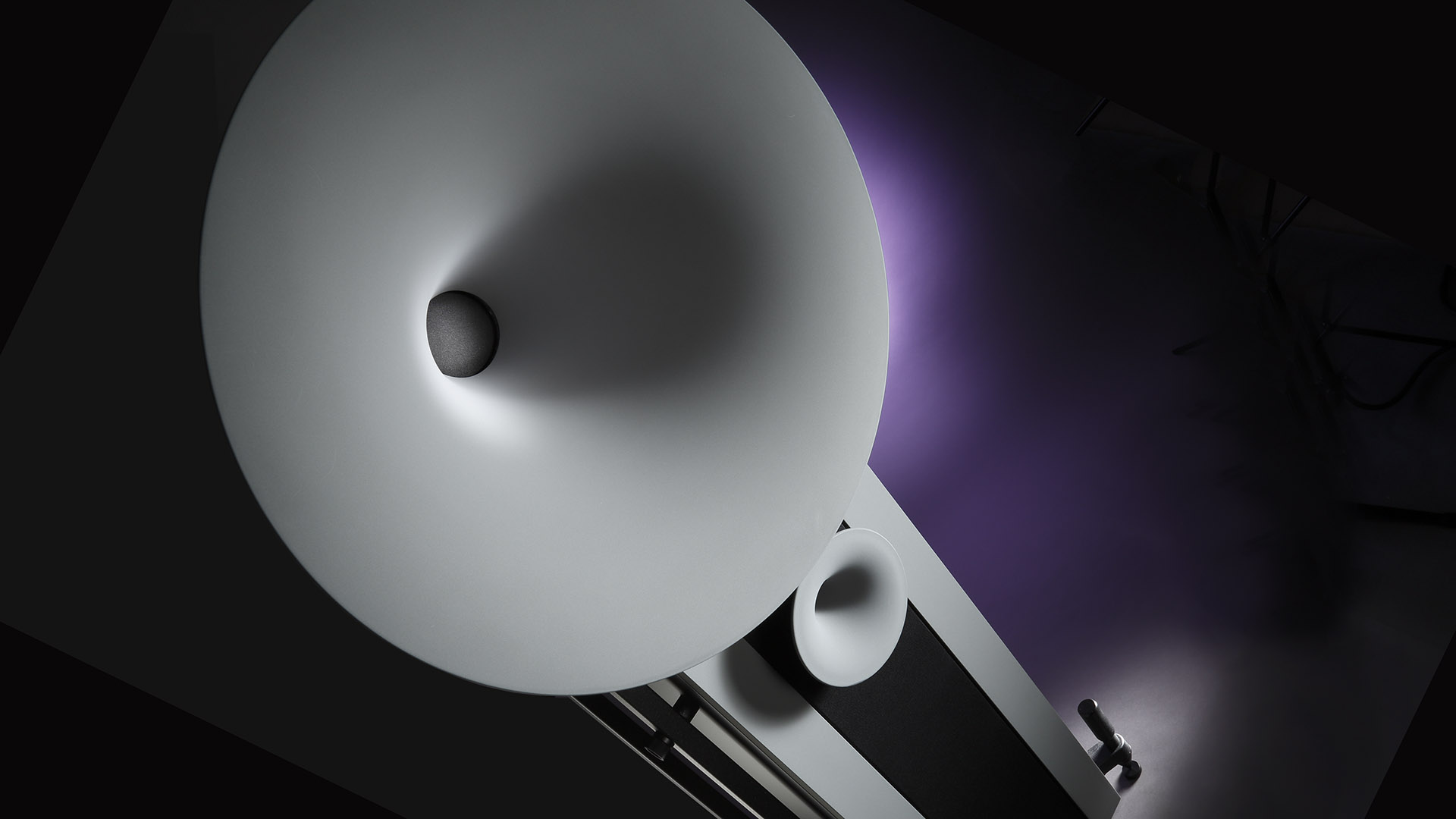
Floorstanding Speaker Test
Avantgarde Acoustic Duo XD Review
Blow Up! – With the Duo XD, Avantgarde Acoustic shows what horn technology and a perfectly matched active woofer are able to do to the sound. Fasten your seatbelts, we're off on journey to the superlatives of hi-fi!
Yes, you have read the measurement results from our lab correctly (in case you checked them): For 94 decibels of sound pressure at a distance of one meter, this speaker needs just 0.07 watts of power. Seven watts would be somewhat normal, 0.7 watts already a sensation – but 0.07 watts reads like a typo. It is completeley tru though! This is made possible by the large horn at the top end of the Duo XD, coming from the specialist Avantgarde Acoustic, based in a small town in the Odenwald mountain range in southwestern Germany. This horn is connected directly to the amplifier without any intermediate crossover and visually symbolizes the phenomenal efficiency with its huge opening of 67 centimeters.
The funnel-horn for the tweeter just below is considerably smaller – this might seem obvious, as little energy is needed for loud high frequencies. The tweeter is located in the front of the woofer cabinet, which is equipped with two 30 mm drivers. Clever and powerful active electronics ensure that the bass doesn't lose connection with the level. In a passive system, this would only be possible with ample drivers and long sound guiding. This way, however, a veritable, but not too protruding woofer module is located in the frame, which is finished in "anthracite metallic" and internally damped against resonance. This frame ends in four elongated feet at the bottom, which gives the Duo XD an almost graceful appearance despite its size and the weight of almost 90 kilograms per piece.
Every Duo is Unique
The eye-catcher is, of course, the large, mathematically precisely calculated, spherical midrange horn, which rests on a tube. This, as well as its tweeter counterpart and the vertical trim panels of the bass cabinet, can be customized in terms of color. Various high-gloss finishes, but also matte versions plus two wood decors for the panels are available. On the website of Avantgarde Acoustic you can have a look at the variants, whereby the range covers a lot, from flashy to dignified. Naturally, we are more interested in the inner values, but like the appearance of our test device in complete "Stealth Nextel Grey", a gray Nextel coating that gives the Duo XD a subtle and noble look that matches the high technical standards the manufacturer has.
A midrange driver with a "Soft Mesh" membrane sits behind the 37-centimeter-long horn, made from the amorphous polymer ABS. Its voice coil runs in the stable field of an "AlNiCo" magnet, an alloy of iron with aluminum, nickel, cobalt, copper and in this case titanium, to which special audiophile qualities have been attributed by high-end enthusiasts.
The funnel for the tweeter, only 18 cm in diameter, is also made of ABS. In this tweeter, a thin, lightweight "Mylar" film does the work, whose motor is a flat ferrite magnet. You can see it when you unscrew the horn, attached via a thread. The narrow cloth cover in the center of the woofer can afterwards be removed, and you immediately see the two big bass drivers right behind it. These are not powered by the main amplifier. Rather, they are powered by a 1000-watt active module, which consists of two effective switching output stages of 500 watts peak power each.
This is controlled by the DSP-based command station, which normally draws its musical information from the main signal, digitizes it and, if desired, processes it in many parameters, converts it again and feeds it to the Class D amps. For this purpose, the listener can call up fixed presets via a small display on the back of the speaker, for example to set the woofer three or six decibels louder or quieter. In the same way, the transmission range of the bass speaker, which extends from about 20 to 200 Hertz and has its upper cutoff frequency at 170 Hz, can be extended or reduced by 30 Hz, which has direct consequences for the homogeneity of voices and instruments.
More interesting, because it is much more complex, sensitive and effective, are the various possibilities the control menu offers. This includes correction curves that exactly match your "playground" and result from a complex measurement procedure in the listening room (see side). With this extensively elaborated tool, Avantgarde Acoustic consistently uses the advantages of active speakers to the improvement of sound quality.
Sound improvements with Compensation
The Duo XD, which is almost as tall as a man, gave us a drastic demonstration of what this means in practice – but first things first: Before evaluating all the technical details, we first placed the speakers, which were set to linear, optimally in the listening room like we do with all the others. The first surprise came right away, because those who suspected that the horns could hardly be tamed were positively disappointed. Even more: Right away, the horns played incredibly believable, cohesive and without the slightest hint of dull discoloration or other limitations. Our joy grew with every centimeter that we moved the Duo XD – with the help of a test song repeated an uncountable amount of times – into the position where they "corresponded" with each other as well as with the room in the best way and thus already sounded outstanding in every respect.
At this point, the test you are reading right now could have ended with a detailed description of the sound, but the highlight was still to come: Two days after the memorable set-up date, we received an email with the compensation curves determined from our room measurements, which were quickly transferred to the speakers. Although our listening room and its setup is fantastic in any way, the difference to the uncorrected performance was simply striking: In Maria Pihl's "Malvina", the slight bloating in the bass range disappeared, but that was not all. Rather – surprise number two – the large-scale and also conscientiously ordered spectrum took a step back, the performance gained spatial depth, clarity and plasticity, which was immediately noticeable to the ear when resetting the correction.
Now the Swedish singer not only stood tangibly between the horns, so that one could listen all around her, as you could say. This was the case because the rich bass no longer encroached on her, and the swaths of synthesizer looming in the background were clearly further away from her, thus bringing incomparably more "air" and naturalness to the performance. The loudspeakers almost "disappeared" into the music, which is especially fascinating when it comes to such full-grown specimens – all in all a great listening experience. Rarely has "Malvina" sounded so convincing and genuine.
Concise to the Point
Now for something curious: Even pieces of music with a supposedly rather low amount of low-frequency content sounded considerably more agile, shadier and more relaxed, especially in the mids and highs – thanks to the compensation, which only reaches up to a maximum of 300 Hertz due to the principle. Thus, the speaker pair gave body to the highly dynamically captured vibraphone in "Saturday Night" by the Red Norvo Quintet – another listening test hit –, let its impulses burst without a break, grouped the band neatly around the central star of this fantastic live recording and set the audience clearly off to the rear. On top of that, there was a realistically mapped out stage and no compression effects in the loud passages. How could there be, given the minimal performance requirements?
Chadwick's orchestral piece "Jubilee," fluctuating between furious attack and heartfelt rhapsody, flowed from the high-tech horns with such elemental power and free breathing that one could only marvel. In general, each piece appeared in that aura of affectless finesse and casual matter-of-factness that defines "true" high end.
Despite lightning-fast speed and elastic conciseness, there was no trace of that rowdy, aggressive attitude that is often associated with horns, often with good reason. In contrast, the Duo XDs produced noblesse that seemed to border on self-denial, and to which – perfection in detail – WBT's "Nextgen" connectors used together with "body silencers" may have contributed to.
Thanks to the extreme efficiency in conjunction with unusually high impedance, any amplifier, no matter how powerful, could play mostly "unloaded" on the Duo XD, which at 10 watts are louder than normal boxes with 1,000. Tube amplifiers thus find virtually ideal conditions. In addition to our tried and tested amps, Avantgarde Acoustics' ultimate preamp/power amp combination XA Pre/XA Power, tailored to the Duos, took part in the listening test – and proved to be a fantastically good addition. However, the speakers presented themselves not only as highly effective, but also as an acoustic magnifying glass that reveals every detail and differences of quality between source devices and amps with brutal honesty – another trump card in the presentation of the Duo XD, which thus easily exceeds our high expectations.
Verdict
The Duo XD is a big hit and combines mature horn expertise with sophisticated active bass technology. Supreme sound even without room adjustment! Compensates immensely open, accurate and lively. No tendency to coloration. A dream of a speaker!
Technical Details
Floorstanding speakers (passive)
Avantgarde Acoustic Duo XD
Price: from 33400 € (Last check: 02.08.2021)
Dimensions WxHxD: 67 x 170 x 60 cm
Weight: 88 kg
Warranty: 5 years (Chassis, Elektronik: 2 Jahre)
Manufacturer: Avantgarde Acoustic

General Data
Measurement Results
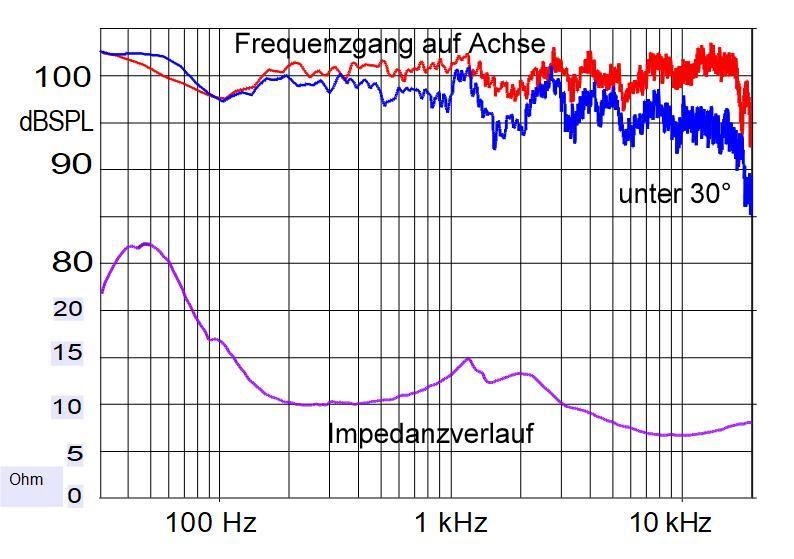
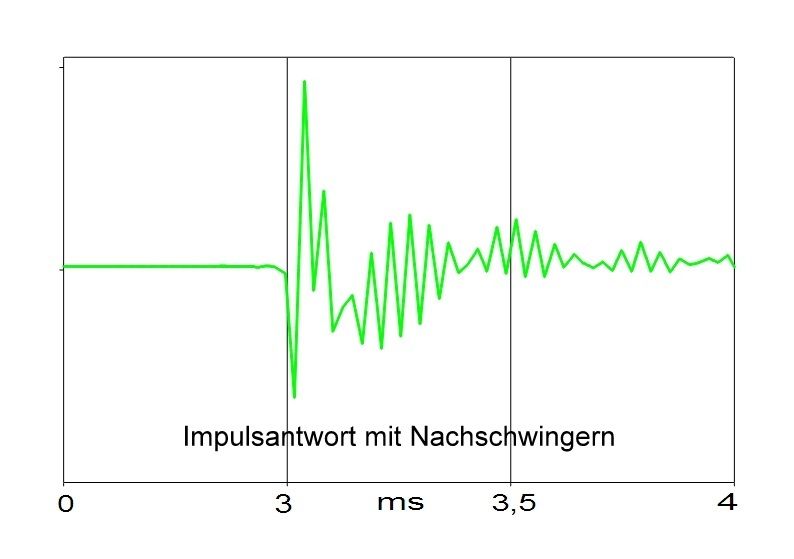
Measurement Values
| Rated impedance at DC: | 8 Ohm |
| Minimum impedance: | 7 Ohm |
| Minimum impedance at: | 10000 Hz |
| Maximum impedance: | 27 Ohm |
| Maximum impedance at: | 48 Hz |
| Sound pressure characteristic (2.83 V/m): | 103 dBSPL |
| Power for 94 dBSPL: | 0.07 W |
| Lower cut-off frequency (-3dBSPL): | <30 Hz |
Stereo Test
Sound Level Floorstanding speaker: 97%
Price/Performance
Lab Comment
Balanced frequency response, extreme efficiency plus high impedance, thus not a "burden" for any amplifier, low lower cut-off frequency.
Active bass module with comprehensive correction options, WBT "Nextgen" connectors, 80 memory slots for presets as well as own compensation settings.
Test Devices
Turntable:
Transrotor Rondino nero/5009/Figaro
Media-Player:
T+A MP3100HV
Integrated Amp:
Audionet WATT
Pre-/Power Amps:
Accustic Arts Tube PreampII-MK2
AmpII-MK4
Avantgarde Acoustic XA Pre/XA Power
Loudspeakers:
B&W 800 D3
Dynaudio Confidence 50
Cables:
HMS Suprema
Silent Wire LS16MKII
Perfection thanks to Room Calibration and DSP-Control
By adjusting the Duo XD to room errors, the sound is enhanced in every respect.
A strong argument for the Duo XD is the possibility to adjust its woofer to the room and its special conditions. Apart from the 20 presets supplied by Avantgarde Acoustic (see below), which provide for certain level adjustments or changes of plus/minus 30 Hertz with regard to the upper cutoff frequency of the midrange horn, whereby voices can be presented somewhat fuller or slimmer, the highlight is the semi-automatic measurement of the listening room and subsequent correction of the reproduction. This happens in the range up to around 200 hertz, but influences the entire sound image.
The procedure is as follows: Either the dealer or Avantgarde Acoustic itself – in our case, this was done by sales manager Babak Moayedpour – determines via a microphone and corresponding measurement program (which instructs you to place it at several locations at and around the listening position), a vast amount of data that goes to the manufacturer, where acoustics specialist Armin Krauss calculates the appropriate correction curve for the left and right speaker. This is then fed to the Duo XD via network or USB interface and stored in one of the free memory slots. Sounds simple? It is! After downloading the program available on their website, we could feed our test boxes with a few clicks – done!
The conditions for the correction system were more difficult because our listening room is already acoustically optimized. Nevertheless, Krauss found some possible improvements. The detailed display of all procedures and changes on the computer monitor is ingenious. At the bottom right of the gallery, we have shown the curve of a channel supplied by Avantgarde Acoustic, including the correction data. There you can see exactly at which corner frequencies and to what extent adjustments were made in terms of quality (Q) and level increases or decreases (gain). The highlight: With the laptop sitting nearby, we could deactivate individual settings by clicking on the blue fields to the left of the parameters and listen to the changes in real time. Another click and the correction at that point was activated again.
In this way, different curves can be programmed according to musical style and listening taste, saved and implemented as needed. Of course, this also applies if you don't use the calibration service, but try to make improvements yourself. You can turn the virtual knobs to your heart's content and try out different limiting filters with different steepness. Here, too, the displayed curve shows every change. To reload the stored curves, you don't have to use your PC or Mac every time. This can be done manually via the small display on the back of the Duo XD. A quick turn and press of the wheel and the speaker follows the desired curve.
If you play around with the numerous setting options, you'll quickly realize where you're going. Nevertheless, experience is necessary in order not to get lost in the jungle of almost limitless possibilities and only "worsen" the sound in the end. After our absolutely positive experience with the measurement and correction service, we strongly recommend it to every owner of a Duo XD.
 MAGAZINE
MAGAZINE